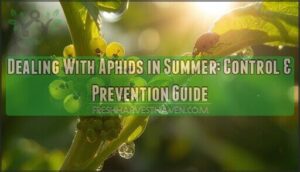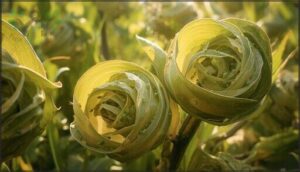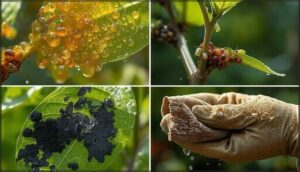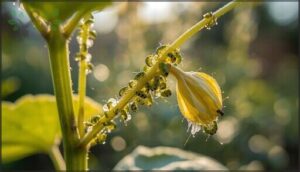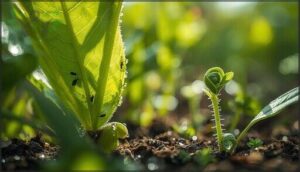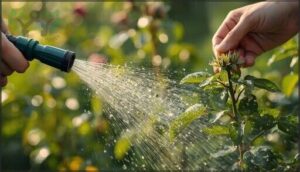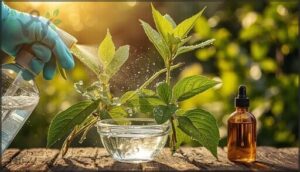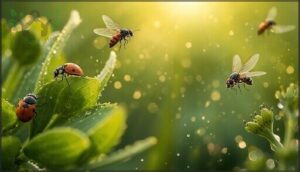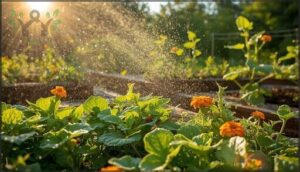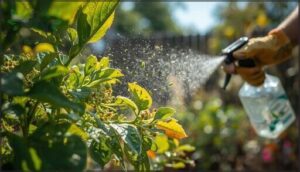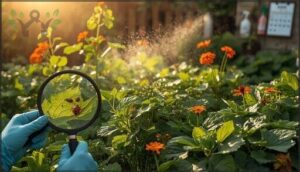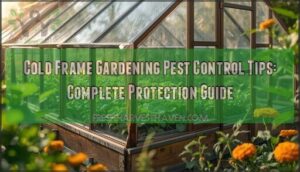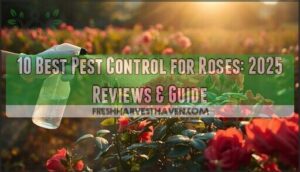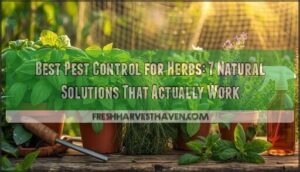This site is supported by our readers. We may earn a commission, at no cost to you, if you purchase through links.
Summer turns your garden into an aphid factory. Between 68°F and 77°F, these pear-shaped pests complete their life cycle in seven days instead of fourteen, doubling their population weekly. Drought stress makes it worse—your struggling plants pump extra sugars into their sap, creating an all-you-can-eat buffet that fuels explosive aphid growth.
A single overlooked colony in June becomes thousands of sap-suckers by July, coating leaves in sticky honeydew and curling new growth into twisted knots.
The good news: summer aphids are soft-bodied and vulnerable, making them easier to control than cold-season pests if you act fast. Catching infestations early and combining physical removal with natural predators gives you the upper hand before populations spiral out of control.
Table Of Contents
- Key Takeaways
- What Are Aphids and Why Target Summer?
- Recognizing Aphid Damage on Your Plants
- Remove Aphids With Water and Hand-Picking
- Apply Soap Sprays and Horticultural Oils
- Recruit Beneficial Insects as Natural Predators
- Prevent Summer Aphid Infestations
- Managing Severe Summer Aphid Outbreaks
- Long-Term Summer Aphid Management Strategy
- Frequently Asked Questions (FAQs)
- Conclusion
Key Takeaways
- Summer heat between 68°F and 77°F accelerates aphid reproduction to a seven-day life cycle, enabling populations to double weekly and turn a single June colony into thousands by July.
- Catching infestations early through twice-weekly scouting and combining physical removal (water sprays, hand-picking) with natural predators (ladybugs, lacewings, parasitic wasps) stops populations before they spiral out of control.
- Avoid overfertilizing with nitrogen during hot months because excess nitrogen creates tender, amino acid-rich growth that aphids prefer and can double their population every two days in temperatures above 25°C.
- Reflective mulch bounces UV light upward to disrupt aphid visual cues, cutting colonization rates by over 70% and reducing virus transmission by 40-50% in vulnerable crops like squash and tomatoes.
What Are Aphids and Why Target Summer?
Aphids are tiny, soft-bodied insects that can turn your summer garden into their personal buffet. These pear-shaped pests multiply at an alarming rate when temperatures rise, making summer their peak season for wreaking havoc on your plants.
Understanding what they look like, why they love the heat, and how quickly they reproduce will help you stay one step ahead of an infestation.
Physical Characteristics of Aphids
You’ll recognize aphids by their soft, pear-shaped bodies, usually 1/16 to 1/8 inch long. Most aphid colonies lack wings, but when stressed, they’ll produce winged morphs to migrate. Each has six legs, two antennae, and rear cornicles that release defensive fluids. Their stylet mouthparts pierce leaves to tap phloem sap.
Aphids exhibit polymorphism, meaning their body shape and color shift across generations, ranging from green to black, red, or brown depending on host plants. They are considered small, sap-feeding insects that often live in large colonies.
Why Aphids Thrive in Summer Heat
Summer heat creates ideal conditions for aphid infestation because temperatures between 68°F and 77°F accelerate aphid metabolism and shorten their life cycle. Your plants face peak risk when weather stays stable in this range—aphids complete development faster, enabling explosive population growth.
Their heat stress response includes enhanced enzyme activity at 82°F, helping them detoxify plant defenses. Drought-stressed plants accumulate extra sugars in sap, boosting aphid nutrition during hot spells.
This climate adaptation means summer ecology favors rapid colonization, threatening plant health when aphid control isn’t proactive. Monitoring crops is key to early detection of aphid infestations.
How Fast Aphids Multiply in Warm Weather
Given those ideal conditions, aphid reproduction accelerates dramatically. At 77°F, you’ll see populations double roughly every week—aphids produce up to 17 offspring per female, with generation turnover complete in just 7–10 days. Temperature effects within 68–77°F create exponential population growth through parthenogenesis:
At 77°F, aphids double weekly through parthenogenesis, producing 17 offspring per female with complete generation turnover in just 7–10 days
- Development shortens by one day per 1.8°F increase
- Reproductive phase extends to 13 days at peak warmth
- Intrinsic growth rates jump from 0.085 to 0.245
- Multiple overlapping generations emerge every two weeks
- Populations collapse above 82°F as thermal limits halt reproduction
Understanding this aphid life cycle helps you time interventions before summer aphid infestation spirals beyond control.
Recognizing Aphid Damage on Your Plants
Spotting aphid damage early can save your plants from serious harm. The symptoms aren’t always obvious at first, but once you know what to look for, you’ll catch problems before they spiral out of control.
Here’s how to identify the telltale signs of an aphid infestation.
Twisted and Curled Leaves
When aphid saliva enters leaf tissue, it disrupts cell expansion, causing the telltale twisted and curled leaves you’ll spot on shoot tips and new growth. This curling reduces photosynthetic efficiency and gas exchange, weakening plant vigor over time. Summer heat accelerates the damage—warm temperatures and elevated CO₂ levels boost aphid feeding efficiency, while drought stress makes leaves more prone to deformation. Different species patterns emerge: plum aphids create tightly rolled leaves, while ash aphids form pseudo-galls. Once curled, leaves often stay deformed permanently, even after aphid control measures succeed.
Look for colonies clustered on the undersides of yellowed leaves—once populations exceed 10 aphids per leaf, visible curling begins, and plant health declines rapidly.
| Aphid Species | Curling Pattern | Timing |
|---|---|---|
| Leaf curl plum aphid | Tightly rolled leaves | Early to mid-spring |
| Green apple aphid | Narrow, twisted foliage | Spring through summer |
| Leafcurl ash aphid | Pseudo-gall formations | Mid-spring onward |
| Woolly apple aphid | Curled spurs with galls | Growing season |
| General infestations | Progressive distortion | Peaks in summer heat |
Sticky Honeydew and Sooty Mold
As aphids feed, they excrete sticky honeydew—a sugar-rich secretion containing up to 38% sucrose—that coats leaves and stems below colonies. You’ll notice this clear, tacky film attracts ants and creates ideal conditions for sooty mold fungi to colonize.
These black fungal layers can block 70% of sunlight, reducing photosynthesis and plant vigor. Washing leaves early prevents mold establishment; insecticidal soap targets aphids directly, stopping honeydew production.
Stunted Growth and Yellowing Foliage
When aphid colonies drain phloem sap for weeks, you’ll see stunted growth and yellowing foliage—two hallmarks of serious infestations.
Sap extraction removes nitrogen and disrupts chlorophyll production, causing leaves to pale within seven days.
Photosynthesis disruption from aphid saliva and honeydew effects can cut efficiency by 27%, weakening roots and slowing shoot elongation, especially during 65–80 °F heat.
Where to Look for Aphids
To catch aphid infestation early, check leaf undersides and shoot tips first—that’s where colonies form on garden plants. Inspect bud clusters and look near veins, where phloem concentration draws these garden pests.
Don’t forget the soil surface around roots, especially if you notice wilting without obvious leaf damage. Aphids favor shaded, sheltered spots with high humidity.
Remove Aphids With Water and Hand-Picking
Sometimes the simplest methods work best when aphids show up on your plants. Water and hand-picking don’t require special products, and they can knock out small to medium infestations quickly.
Let’s look at how to use these straightforward techniques to clear aphids from your garden.
Using a Strong Hose Stream
Your garden hose doubles as your first line of defense against aphid infestation—and it works remarkably well. A strong hose stream dislodges over 90% of aphids from infested leaves during the initial treatment. Most aphids won’t return because the water damages their piercing mouthparts.
Target both upper and lower leaf surfaces, adjusting your nozzle pressure to avoid harming tender growth. Spray every 2–3 days in early morning for best timing and plant health impact.
Manual Removal Techniques
When just a handful of aphids appear, your fingers become precision tools. Hand-squashing aphids eliminates up to 85% of visible pests in one session, and you don’t need gloves—just gently pinch soft-bodied insects between thumb and forefinger on sturdy leaves.
For broader coverage, try inspecting and wiping foliage with a damp tissue to trap stragglers. Pruning infested parts works when colonies cluster on shoot tips, and the bag-and-remove method prevents spread during cuts.
Daily visual checks catch outbreaks early, keeping aphid control manageable without a hose nozzle.
Best Times of Day to Spray
Timing your spray is like choosing when to water—early morning before 8 a.m. or evening after 6 p.m. keeps aphid control effective while protecting plants. Temperature effects matter: midday heat above 30°C evaporates insecticidal soap and neem oil before they work, and horticultural oil can burn leaves in direct sun.
Best spray windows align with biological rhythms, catching aphids during cooler hours when environmental factors support contact action and beneficial insects stay inactive.
Apply Soap Sprays and Horticultural Oils
When water alone won’t cut it, soap sprays and horticultural oils step in to finish the job. These solutions work by coating aphids and breaking down their soft bodies, making them effective tools in your summer control plan.
Here’s how to mix, apply, and use these treatments safely.
Making Homemade Dish Soap Solution
You can whip up a natural remedy with common dish soap and water to kill aphids on contact. Soap disrupts their soft bodies, causing rapid dehydration. Here’s how to mix an effective homemade soap spray:
- Start with the right soap concentration: Use 1–2 teaspoons of mild dish soap per pint of water, or about 1 tablespoon per gallon for larger batches—roughly 0.5–2% concentration.
- Avoid harmful soap additives: Skip soaps with degreasers, bleach, or antibacterial agents, which increase plant sensitivity and can scorch foliage.
- Choose your application method carefully: Apply as a fine mist targeting leaf undersides where aphids cluster, spraying during cooler morning or evening hours.
- Consider rinsing foliage: Rinse plants 2–4 hours after applying soapy water to prevent residue buildup that may stress sensitive varieties.
Test your homemade soap spray recipes on a small leaf section first and wait 24–48 hours to check for damage before full application.
When to Apply Horticultural Oils
Horticultural oil works best during summer when temperatures stay between 40°F and 70°F with stable conditions for 24 hours afterward. Apply these summer formulations—sometimes called refined oils—during early morning or late afternoon to avoid midday heat that can scorch leaves.
Don’t spray when temperatures exceed 90°F or when humidity climbs above 65%, as slow evaporation increases leaf burn risk.
Target aphids near active growth before infestations explode during rapid summer reproduction cycles.
Application Safety and Frequency
Once you’ve chosen the right conditions, keep these safety guidelines in mind. Oil Sensitivity varies by plant—ferns and maples burn easily, so check tolerance before spraying. Temperature Limits matter: never apply above 90°F, and stay below 85°F for stressed plants.
For Aphid Control and effective Pest Management Strategies:
- Spray two times, 3–5 days apart, targeting both leaf surfaces
- Wait two weeks before starting another treatment cycle if needed
- Mix oil fresh each time and keep your sprayer agitated
- Avoid winds over 10 mph to prevent drift
- Don’t combine oils with other products without cutting concentration to 1%
Reapplication Timing and proper Spray Intervals make sure you kill emerging nymphs without harming your plants—a core principle in Organic Gardening Methods.
Recruit Beneficial Insects as Natural Predators
Nature’s got your back for aphid control. Beneficial insects act as tiny pest-management teams, hunting down aphids without chemicals or daily effort from you.
Let’s look at which helpful bugs work best and how to bring them to your garden.
Lady Beetles and Lacewings for Control
Lady beetles and lacewings are your frontline aphid predators in summer. Adult lady beetles can devour up to 5,000 aphids over their lifespan, while their larvae show even higher predation efficiency. For effective biocontrol, maintain a prey-predator ratio below 450 during peak growth. Release about 1,500 lady beetles twice weekly for heavily infested plants.
Lacewing larvae work best at a 1:50 ratio—releasing them early targets low aphid densities before outbreaks escalate.
Notably, lady beetle odor chemical cues alone reduce aphid populations by 25%, disrupting their feeding and reproduction without direct contact.
Attracting Parasitic Wasps
Because parasitic wasps lay eggs inside aphids—turning them into immobile “mummies”—you’ll want to roll out the welcome mat with nectar sources. A single female wasp can parasitize up to 200 aphids in summer, achieving chemical-free control that aids ecosystem stability and integrated pest management. Your plant selection matters:
- Dill, fennel, and coriander extend wasp lifespan by 2–3 times
- Sweet alyssum and cosmos increase wasp abundance by over 40%
- Buckwheat and purple tansy boost parasitism rates by 25–60%
- Carrot family flowers provide continuous summer blooming
- Avoid pesticides—they reduce parasitoid survival by 90% within 48 hours
This natural predator encouragement creates wasp habitat that sustains beneficial insects across growing seasons.
Creating Habitat With Flowering Plants
Beyond attracting natural predators, you’ll build long-term aphid resistance by establishing flowering plant corridors that deliver floral diversity, buffer zones, and resource timing designed for enemy recruitment.
Integrated pest management relies on companion plants that support beneficial insects through sustainable gardening practices—buckwheat, alyssum, and coriander planted in succession supply nectar through summer’s heat.
VOC influence from aromatic herbs like basil repels colonizing aphids while lady beetles and hoverflies patrol your crops, completing a self-sustaining defense system.
Prevent Summer Aphid Infestations
The best defense against summer aphids is prevention. You can take steps before pests arrive to make your garden less inviting.
Here are four practical ways to stop aphids before they become a problem.
Avoid Overfertilizing During Hot Months
Here’s the thing: too much nitrogen creates a pest paradise. Excess nitrogen generates lush, tender growth that aphids love, while also boosting amino acid concentrations in plant tissues. Summer heat compounds this problem—temperatures above 25°C accelerate aphid reproduction, and nitrogen-rich foliage doubles their population every two days.
Stick to moderate nitrogen levels, around 0.9 g/kg, to suppress aphid populations by 40–50%. Switch to slow-release or organic fertilizers to maintain lower tissue nitrogen content and stronger plant defenses. Balanced nutrients with adequate potassium build thicker leaves that resist aphid feeding.
Use Reflective Mulch to Repel Aphids
Reflective mulch works like a mirror that confuses aphids. Silver or aluminum mulches bounce UV light upward, disrupting aphid visual cues and cutting alighting rates by over 70%. This IPM integration strategy also slashes virus transmission in squash and tomatoes by 40–50%, while boosting agronomic performance through better yields and weed suppression.
- Install silver polyethylene mulch before aphid colonization peaks for maximum protection
- Secure edges tightly to maintain consistent UV reflection across your crop canopy
- Combine with beneficial insects and reduced insecticide sprays for sustainable pest management
- Remove temporarily during extreme heat to prevent crop overheating and stress
Companion Plants That Deter Aphids
Certain companion plants work like bodyguards for your crops, releasing natural compounds that aphids can’t stand. Rosemary VOCs interfere with aphid host-location signals, cutting settlement by over 60%. Marigold intercropping slashed aphid densities up to 57% in field trials, while garlic’s effect masked host odors and halved population growth.
Plant these organic gardening allies near vulnerable crops to boost pest control and attract beneficial insects for stronger defenses.
Regular Scouting and Early Detection
Scouting frequency matters—aphid infestations can double weekly in summer heat. Walk your garden every 7–10 days, checking undersides of leaves and shoot tips for pest identification. Look for honeydew indicators like sticky residue or sooty mold, twisted foliage, and white cast skins. High-risk fields near wooded edges need extra attention. Winged adults signal crowding and spread risk.
Imaging advances like hyperspectral sensors now detect early signs of aphid damage before visible symptoms appear, helping you stay ahead.
Managing Severe Summer Aphid Outbreaks
Sometimes, despite your best efforts, aphids overwhelm your garden faster than basic controls can handle. When infestations spiral out of control, you’ll need stronger measures to regain the upper hand.
Here are three targeted approaches for serious summer aphid problems.
Neem Oil as an Organic Option
When aphid numbers climb beyond what water or soap can manage, neem oil offers a plant-derived solution with proven field efficacy. Its active compound azadirachtin disrupts aphid reproduction and feeding without harming beneficial insects, making it ideal for organic gardening and natural remedies.
- Application timing: Mix 5 ml neem oil with 2.5 ml soap per liter, spray early morning or evening to prevent leaf burn
- Field efficacy: Reduces aphid populations by 48–70% within two days, with reapplication every 7–14 days during peak summer
- Environmental safety: Biodegradable, EPA-registered for food crops, won’t harm pollinators or earthworms
- Economic factors: Cost-benefit ratio reaches 1:2.77 when integrated with other aphid control methods
When to Consider Systemic Pesticides
When neem oil falls short against persistent populations, systemic pesticides become your next option. These insecticides absorb through plant tissues, reaching hidden aphids inside leaf curls or deep canopies where sprays can’t penetrate.
Use them when repeated issues plague the same plants each season, when greenhouse scenarios demand long-term protection, or when control failure threatens crop value despite multiple attempts with contact methods.
Protecting Beneficial Insects While Treating
When treatments can’t wait, timing applications and targeted spraying protect aphid predators while controlling pests. IPM strategies balance chemical use with natural pest control, keeping your garden’s ecosystem intact.
- Apply insecticidal soap or organic controls in the evening when pollinators rest—reducing exposure by 75%.
- Wait 3–5 days after spraying before releasing beneficial insects like lacewings.
- Plant companion plants such as dill and fennel to shelter surviving predators during treatment.
- Spot-treat heavily infested areas only instead of blanket spraying your entire garden.
- Use habitat enhancement techniques like flowering strips to speed recolonization after applications.
Long-Term Summer Aphid Management Strategy
You can’t just spray aphids once and expect them to vanish for good. Keeping your plants aphid-free through summer takes a steady routine, a mix of tactics, and the flexibility to shift gears when needed.
Here’s how to build a management strategy that works all season long.
Weekly Plant Inspection Routines
Think of pest prevention like catching a leak early—weekly checks stop small problems from turning into disasters. During summer, inspect your garden every seven days, focusing on new growth where aphid infestations start. Use a hand lens to spot tiny colonies on leaf undersides, and log what you find in a notebook. This simple routine cuts major outbreaks by 60% and helps you track seasonal factors affecting plant health. Technology integration, like yellow sticky traps, supplements visual monitoring techniques for complete coverage.
Consistent data logging turns random checks into reliable pest prevention.
| When to Inspect | What to Check | Tools to Use |
|---|---|---|
| Early morning or late afternoon | Undersides of young leaves | 10× hand lens |
| Twice weekly during peak heat | New shoots and flower buds | Yellow sticky traps |
| After watering or rain | Sticky honeydew on stems | Inspection notebook |
| Before applying treatments | Overall plant health signs | Garden hose for testing |
Combining Multiple Control Methods
Since no single approach alone guarantees lasting success, Integrated Pest Management combines biological controls, chemical alternatives, and cultural practices into unified aphid control methods.
Alternate water sprays with insecticidal soap every seven days, then release beneficial insects like lady beetles during cooler mornings.
Neem oil applications paired with reflective mulch and companion planting deliver combined strategies that reduced aphid populations by 80% in organic gardening trials while protecting natural predators.
Adjusting Tactics Based on Infestation Levels
When do you escalate from gentle tactics to stronger control frequency? Threshold-based intervention studies show that once aphid counts exceed 250 per plant, biological balance shifts, demanding targeted insecticidal soap or neem oil treatments.
Precision monitoring lets you detect population spikes early, protecting beneficial insects while maintaining organic gardening standards.
Post-intervention metrics confirm success—if aphid control methods don’t reduce numbers within 72 hours, switch approaches immediately.
Frequently Asked Questions (FAQs)
Can aphids survive on indoor houseplants too?
Yes, aphids don’t discriminate—they’re just as happy munching on your fiddle-leaf fig as your roses.
Indoor aphid species like green and black aphids thrive at 65-80°F, reproducing rapidly and weakening plant health through sap-feeding and honeydew production.
Do aphids bite or harm humans directly?
Aphids don’t bite humans. Their mouthparts are specialized stylets designed for piercing plant tissues, not human skin.
You might experience mild skin irritation or allergic reactions from contact, but aphids can’t transmit diseases to you.
What attracts aphids to certain plants initially?
Like moths to a flame, aphids zero in on plants through chemical signals and visual cues. Plant VOCs—especially from stressed or nitrogen-rich plants—draw them in, while yellow and green wavelengths catch their eye, guiding them to tender new growth.
How long do individual aphids typically live?
Under ideal conditions, individual aphids live about one month. Temperature plays a major role—warmer conditions speed up reproduction but shorten lifespan, while cooler weather extends it slightly.
Aphids reach maturity in just four to ten days.
Can aphids transmit diseases between different plants?
Yes, they do. Aphids transmit plant viruses between different plants through their feeding activity. When they feed on infected plants, virus particles attach to their mouthparts or enter their bodies, then transfer to healthy plants during subsequent feeding.
Conclusion
Think of summer aphid control like fighting a wildfire—you can’t just douse one spot and walk away. Dealing with aphids in summer demands vigilance across your entire garden, combining physical removal, beneficial predators, and smart prevention into a single defense system.
Scout your plants twice weekly, rotate your control methods to keep aphids off-balance, and resist the urge to overfertilize when heat peaks.
Stay consistent through August, and you’ll turn that aphid factory into a balanced ecosystem where pests never gain the upper hand.
- https://pubmed.ncbi.nlm.nih.gov/14641981/
- https://arxiv.org/html/2310.03058v2
- https://hgic.clemson.edu/factsheet/integrated-pest-management-i-p-m-for-aphids/
- https://pmc.ncbi.nlm.nih.gov/articles/PMC8227038/
- https://www.frontiersin.org/journals/ecology-and-evolution/articles/10.3389/fevo.2022.794495/full

